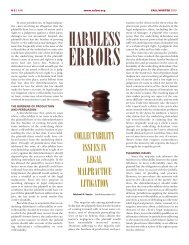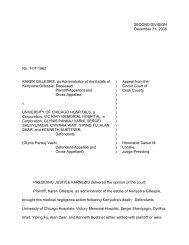Financial Services - SmithAmundsen LLC
Financial Services - SmithAmundsen LLC
Financial Services - SmithAmundsen LLC
Create successful ePaper yourself
Turn your PDF publications into a flip-book with our unique Google optimized e-Paper software.
M A R C H 2 0 0 8<br />
l a w f r o m a b a n k e r ’ s p e r s p e c t i v e<br />
Inside this issue<br />
CONTENTS:<br />
• Defending Against Claims of Loan<br />
Re-Characterization and Equitable<br />
Subordination......................................................................................1<br />
• The ECOA and Obtaining Spouse’s Signature on<br />
Personal Guaranties.........................................................................2<br />
• Conventional Subrogation: Released Mortgages<br />
Breathe New Life..............................................................................2<br />
QUARTERLY CONTRIBUTORS:<br />
• Michael G. Cortina, Editor<br />
• Thomas P. Scherschel<br />
• Bradley G. Rausa<br />
FINANCIAL SERVICES ATTORNEYS:<br />
• Michael G. Cortina<br />
• Brian M. Graham<br />
• Ean L. Kryska<br />
• Linda M. Kujaca<br />
• Bradley G. Rausa<br />
• Thomas P. Scherschel<br />
• Heather E. Shea<br />
• Kelly N. Stulginskas<br />
to <strong>SmithAmundsen</strong> clients.<br />
<strong>Financial</strong> <strong>Services</strong><br />
q u a r t e r l y<br />
Defending Against Claims of Loan<br />
Re-Characterization and Equitable<br />
Subordination<br />
By Bradley G. Rausa<br />
In American National Bank & Trust Co. v. Matrix IV, Inc., 332 B.R. 346 (Bankr.<br />
N.D. Ill. 2005), the debtor filed Chapter 11 bankruptcy, and a lien priority<br />
dispute arose between two creditors, American National Bank & Trust Co.<br />
(“Bank”) and Matrix IV, Inc. (“Matrix”), stemming from lines of credit each<br />
had extended to the debtor. The Bank had recorded its lien and Matrix had not,<br />
so the Bank’s lien primed any lien owned by Matrix.<br />
Matrix sought nonetheless to subordinate the Bank’s lien under theories of<br />
re-characterization and equitable subordination. Re-characterizing a debt as<br />
equity automatically subordinates the debt to those owed to other creditors.<br />
The Bank’s loan was structured as a revolving credit line to debtor based upon<br />
a percentage value of debtor’s receivables and inventory. Among other things,<br />
Matrix alleged that the Bank’s loan was an equity infusion because (1) two of<br />
the Bank’s customers bought a 49% interest in debtor (for $200,000 of stock<br />
and a $500,000 loan); (2) the debtor had an agreement with those same two<br />
customers whereby she could repurchase the stock sold to them if they failed<br />
to secure working capital for debtor; (3) after the loan was secured, debtor<br />
agreed to waive this right to repurchase stock; (4) debtor and the two customers<br />
personally guaranteed the Bank’s loan; (5) the two customers pledged all of their<br />
common stock in the debtor to the Bank.<br />
In adjudicating the Bank’s motion to dismiss, all of the above facts were<br />
assumed to be true, and the U.S. Bankruptcy Court held that Matrix had failed<br />
to assert facts that would support re-characterization of the loan. There was<br />
no indication that the Bank had become a joint venturer or equity participant;<br />
although the Bank received a pledge of stock as collateral, the Bank did not<br />
execute on that pledge; and no facts were asserted showing that the two<br />
customers were instrumentalities of the Bank or vice versa. In summary, Matrix<br />
had failed to show that the Bank did anything more than make and protect a<br />
commercial loan.<br />
Equitable subordination allows a bankruptcy judge to subordinate all or a part<br />
of a creditor’s claim if that creditor has engaged in misconduct. Where the<br />
creditor is an insider or fiduciary, some material evidence of unfair conduct<br />
must be presented. Among other things, Matrix argued that the Bank was<br />
an insider of the debtor because (1) the debtor consulted the bank on major<br />
business decisions; (2) the Bank required debtor to hire a business consultant<br />
that only the Bank could approve of; (3) under a stock pledge agreement the<br />
Bank could have acquired the right to sell all of debtor’s stock for simply not<br />
informing the Bank of Matrix’s lien; and (4) the Bank had control over which<br />
continued...<br />
1
Continued...<br />
A d e f e n d i n g a g a i n s t c l a i m s o f l o a n r e - c h a r a c t e r i z a t i o n<br />
a n d e q u i t a b l e s u b o r d i n a t i o n<br />
creditors were paid after debtor defaulted on the loan and the<br />
Bank used that control to pay itself and the two customers who<br />
held a proprietary interest in the debtor company.<br />
Once again, these facts were assumed to be true, and the<br />
bankruptcy court held that they did not support a finding that<br />
the Bank was an insider. The facts did not show that the Bank<br />
had de facto or legal control of debtor, nor that the debtor was<br />
a subsidiary of the bank. There was no indication that the<br />
Bank managed, to any degree, the day-to-day operations of the<br />
debtor, and the Bank exercised no option to sell debtor’s stock.<br />
The actions taken by the Bank were designed to manage the<br />
risks to its collateral, not to manage the debtor.<br />
The ECOA and Obtaining<br />
Spouse’s Signature on Personal<br />
Guaranties<br />
By Thomas P. Scherschel<br />
The Equal Credit Opportunity Act (“ECOA”), 15 U.S.C. § 1691<br />
et seq. and its implementing regulations, Regulation B, 12 C.F.R.<br />
§ 202.1 et seq. ordinarily prohibit a creditor from requiring a<br />
spouse’s signature on a note when the applicant qualifies for<br />
credit, individually. Violation of these terms can invalidate<br />
personal guaranties, altogether. The regulations provide<br />
that a lender may not require the signature of an applicant’s<br />
spouse or any other person, such as a parent or any other cosignor,<br />
other than a joint applicant on any credit instrument,<br />
if the applicant himself or herself qualifies under the creditor’s<br />
standards of creditworthiness for the amount and the terms of<br />
credit requested. County Banking and Trust Company v. Lacey,<br />
C.A. No. 146-MRT-90.<br />
In County Banking v. Lacey, after debtors defaulted on a<br />
commercial loan, debtors claimed the lender violated the ECOA,<br />
15 U.S.C. § 1691 et seq. and its implementing regulations 12<br />
C.F.R. § 202.1 et seq., when the lender originally required the<br />
signature of debtor’s spouse on a personal guaranty, thereby<br />
barring the lender from recovering any monies pursuant to<br />
the personal guaranties signed by debtor and his spouse. The<br />
lender had indeed required the signature of the debtor’s spouse<br />
on a personal guaranty, collateralized by property which was<br />
jointly owned by both the debtor and his spouse.<br />
The County Banking Court found that the lender’s policy<br />
of requiring the co-owners of jointly held assets to co-sign a<br />
guaranty was not the equivalent of a requirement that the<br />
borrower’s spouse co-sign a guaranty. The court also found<br />
the lender’s policy was consistent with Regulation B in that §<br />
202.7(d)(2) permits a creditor to require the co-owner to sign<br />
an instrument the creditor believes necessary to enable the<br />
lender to reach the property being offered as collateral in the<br />
event of the default of the primary applicant.<br />
As a footnote to the above, after failing to collect the<br />
entire indebtedness from other debtors on the same note, the<br />
bank attempted to foreclose on the subject jointly owned<br />
collateral. However, the bank failed to collect on the collateral<br />
as there was evidence the bank, during the foreclosure process,<br />
accepted a mortgage on other property from the same debtors,<br />
who successfully claimed that act constituted accord and<br />
satisfaction.<br />
Conventional Subrogation:<br />
Released Mortgages Breathe New<br />
Life<br />
By Michael G. Cortina<br />
In 2007, the Appellate Court of Illinois, Second District, decided<br />
the case of Unionbank v. Thrall, 374 Ill. App. 3d 785 (2d Dist.<br />
2007). The Thrall case began in 1996, when Eureka Savings<br />
Bank (“Eureka”) recorded mortgages on properties in Sandwich<br />
and Somonauk, Illinois. In 1999, Union Bank (“Union”)<br />
recorded mortgages on the same properties. In 2001, Eureka<br />
recorded mortgages on the two properties and released its 1996,<br />
mortgages. The trial court found Union’s liens to be prior<br />
based on the first in time, first in right principle (i.e. whoever<br />
records their liens first has priority). Eureka contended that<br />
its 2001, liens were prior in time based on the legal theory of<br />
conventional subrogation. It argued that its 2001, mortgages<br />
were merely replacements of the 1996, mortgages, and were<br />
therefore entitled to retain the priority of the 1996, mortgages.<br />
The term “conventional subrogation” was first used by the<br />
Illinois Supreme Court in the 1800’s. When first used, the<br />
court defined the term as an “equitable right springing from<br />
an express agreement with the debtor, by which one advances<br />
money to pay a claim for the security of which there exists a<br />
lien, by which agreement he is to have an equal lien to be paid<br />
off.” The problem to be determined by the appellate court was<br />
the fact that the Supreme Court has never used the phrase in the<br />
situation in which the original lienor refinances the initial loan<br />
and takes a new mortgage in return, but does so intending to<br />
maintain its own priority.<br />
continued...<br />
2
Continued...<br />
c o n v e n t i o n a l s u b r o g r a t i o N : r e l e a s e d m o r t g a g e s b r e a t h e<br />
n e w l i f e<br />
The appellate court looked at four elements to determine if<br />
Eureka’s 2001, mortgages fit within the confines of conventional<br />
subrogation. The elements were: 1. the refinancing lienor must<br />
have intended to retain the priority of his original mortgage;<br />
2. the new mortgage must have been used to pay off the first<br />
mortgage; 3. the intervening lienor must have been on notice<br />
of the original mortgagee’s priority at the time he issued the<br />
indebtedness secured by the mortgage; and 4. the first mortgage<br />
must not have been released prior to the intervening lien.<br />
The court determined that if a bank meets all four criteria, then<br />
the doctrine of conventional subrogation would apply. In this<br />
particular case, the court remanded the case to the trial court to<br />
determine whether Eureka intended to retain its priority when it<br />
refinanced and released the 1996, mortgages.<br />
While conventional subrogation may have saved Eureka Savings<br />
Bank from being relegated to a second mortgage position, the<br />
better practice is simply to avoid the situation in the first place.<br />
The better practice is to run a title search on the property<br />
prior to the refinance. If an intervening lien appears, obtain a<br />
subordination agreement with the intervening lienholder prior<br />
to the refinance. This will avoid the need to litigate the lien<br />
priority in the trial and appellate courts and rule-out a priority<br />
challenge from the junior lienholder.<br />
About<br />
<strong>SmithAmundsen</strong><br />
<strong>SmithAmundsen</strong> <strong>LLC</strong> offers experienced, efficient<br />
and proactive counsel on a wide range of legal and<br />
business issues. Our goal is to become our clients’<br />
primary source for legal services and business<br />
advice, the lawyers you turn to when you need to<br />
“get it done right.” In addition to litigation, we also<br />
practice non-traditional means of resolving cases.<br />
We understand the importance of “bottom line”<br />
analysis in our legal advice to clients.<br />
<strong>SmithAmundsen</strong> combines litigation expertise<br />
with a practical business approach to offer<br />
client-centered services in an efficient manner.<br />
Trial work is our litigators’ craft. Our trial<br />
experience and courtroom knowledge has built<br />
a loyal clientele, leading many clients to request<br />
our services on a regional and national basis<br />
in all aspects of legal representation. SA is<br />
experienced in the matters most vital to business<br />
and is committed to providing ongoing counsel<br />
to support and protect the growth of our clients’<br />
organizations.<br />
OFFICE LOCATIONS<br />
150 North Michigan Avenue<br />
Suite 3300<br />
Chicago, Illinois 60601-7524<br />
(312) 894-3200<br />
2460 Lake Shore Drive<br />
Woodstock, Illinois 60098-2664<br />
(815) 337-4900<br />
Stewart Square<br />
308 West State Street<br />
Suite 320<br />
Rockford, Illinois 61101-1140<br />
(815) 987-0441<br />
415 West Washington Street<br />
Suite 204<br />
Waukegan, Illinois 60085-5564<br />
(847) 599-9503<br />
3815 East Main Street<br />
Suite A-1<br />
St. Charles, Illinois 60174-2488<br />
(630) 587-7910<br />
4811 South 76th Street<br />
Suite 306<br />
Milwaukee, Wisconsin 53220<br />
(414) 282-7103<br />
This newsletter is intended to provide information of general interest in a summary manner and should not be construed as providing<br />
legal advice. Readers should consult with counsel before acting on the information contained in this publication. All rights reserved.<br />
3








